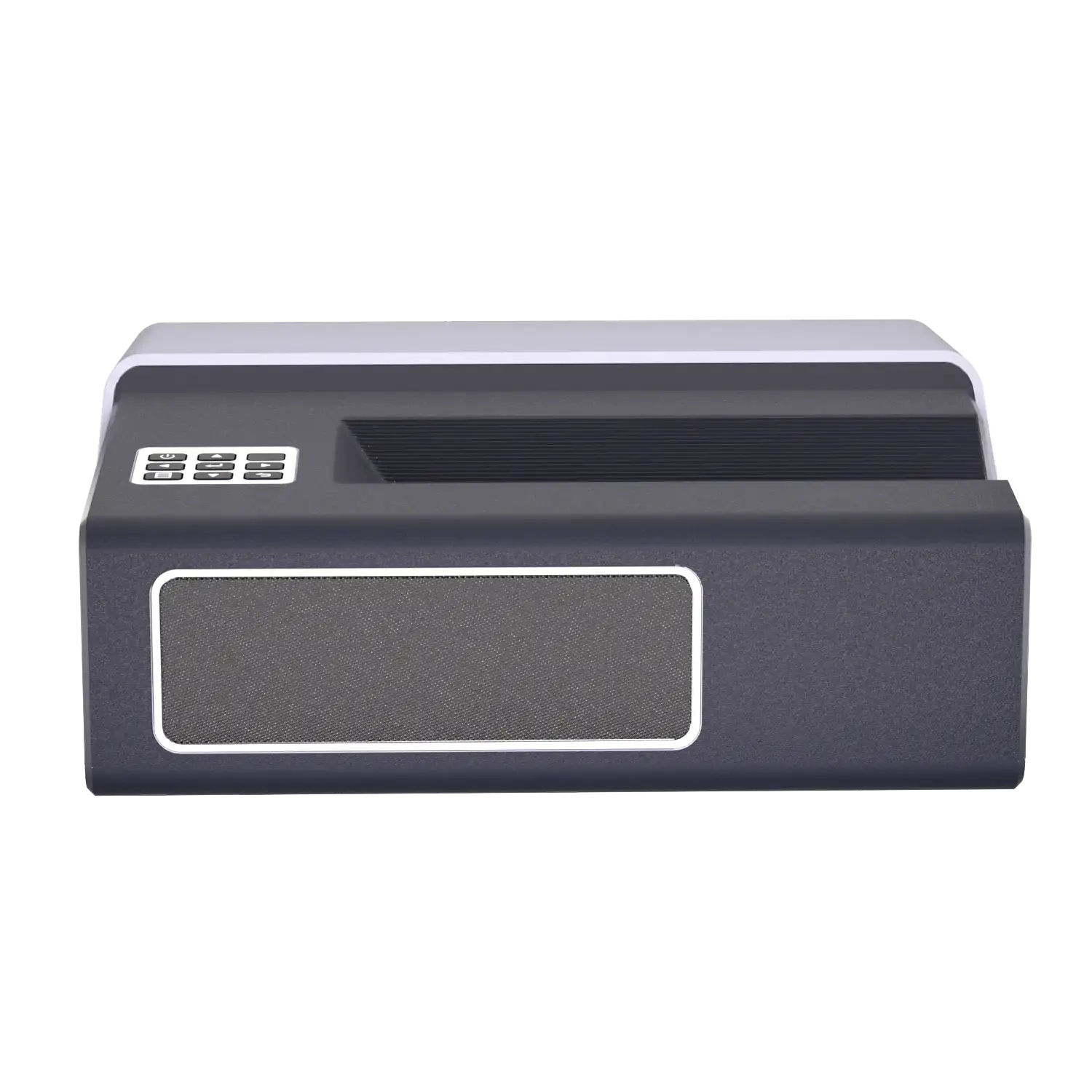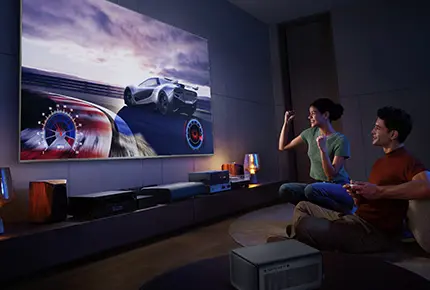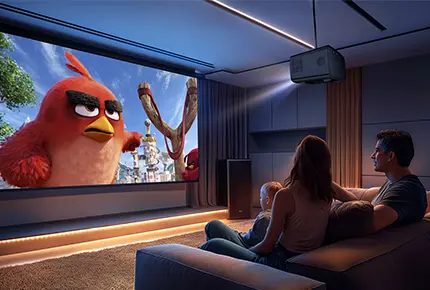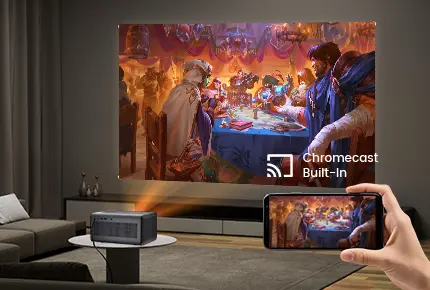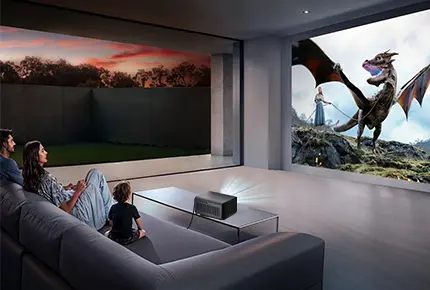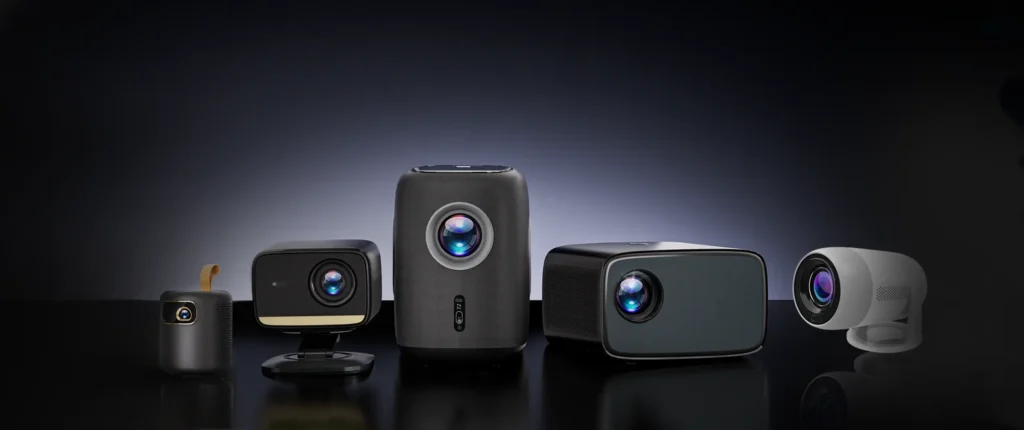
The projector has a long history; it appeared in ancient times. But now, the projector has entered a new era, featuring more advanced technology and greater intelligence. So, what is a projector?
The Definition of a Projector
A projector is an optical device that projects images, videos, or slides onto a screen or surface by directing a beam of light through lenses or digital processing systems. It translates input signals (from computers, DVDs, etc.) into visible displays and is widely used in education, entertainment, business, and home settings.
How Does a Projector Work?
The working principle of a projector is based on optical image formation technology. The image signal is converted into a visible, enlarged image through the light source, imaging elements, and optical system. Different types of projectors have significant differences in core technologies and imaging methods.
The Basic Working Principle of Projectors:
The core process of a projector is divided into four stages:
Light Source Emission:Strong light is generated using bulbs (high-pressure mercury lamps), LEDs, or laser light sources.
Image Formation:The light passes through optical elements (e.g., liquid crystal panels, DMD chips) to form image signals.
Image Composition:RGB colors are overlaid through a prism or optical system to form a full-color image.
Amplified Projection:The composite image is enlarged through a lens system and projected onto the screen.
The Types of Projectors and Their Mainstream Display Technologies
LCD (Liquid Crystal Display) Projectors
Single-panel LCD: Uses one LCD panel to control RGB light transmission. Simple structure but inferior in color and brightness.
Three-panel LCD (3LCD): Employs three independent LCD panels for RGB colors, offering higher color accuracy.
Workflow:
Light source → Dichroic mirrors split light into RGB.
Each color passes through its LCD panel, where pixel transparency is controlled to form monochrome images.
A prism combines the three images into full color → Projection via lens.
Features: High color vibrancy, but lower contrast and susceptible to dust.
Koonew LCD Home Theater Projector: K-300A
DLP (Digital Light Processing) Projectors
Core Component: DMD (Digital Micromirror Device) chip with millions of micromirrors, each representing a pixel.
Workflow:
2.1. Light passes through a rotating color wheel (RGB/RGBW segments).
2.2. Colored light reflects off the DMD chip; micromirrors tilt (±12°) to direct light toward or away from the lens.
2.3. Rapid mirror movement creates grayscale and color images via temporal blending.
Single-chip DLP: Compact, cost-effective, but may exhibit the “rainbow effect” (color separation artifacts).
Three-chip DLP: Uses separate DMDs for RGB, eliminating the rainbow effect. Used in high-end applications.
Features: High contrast, minimal motion blur, and dust-resistant sealed design.
Koonew Mini Rechargeable DLP Projector: A-2341G
CRT (Cathode Ray Tube) Projectors
Technology Principle: Three CRT tubes emit electron beams to excite RGB phosphors, generating images projected via lenses.
Workflow:
3.1. Input signal splits into RGB channels.
3.2. Electron beams scan phosphor screens to create monochrome images.
3.3. Optics merge and project the combined image.
Features: Exceptional color gradation, but bulky, low in brightness, and largely obsolete.
LCOS (Liquid Crystal on Silicon) Projectors
Technology Principle: A hybrid of LCD and DLP; reflective LC panels modulate light per pixel.
Features: High resolution with minimal pixel grid visibility, ideal for professional settings but costly.
Other Projector Classifications - By Light Source & Application
By Light Source:
Traditional Lamp Projectors (UHP/UHE, etc.)
Advantages:
High Brightness: Up to 3,000–5,000 lumens in full-power mode, suitable for bright environments.
Low Cost: Mature technology with affordable bulbs and replacements.
Natural Colors: Continuous white-light spectrum ensures good color accuracy (especially in 3LCD models).
Disadvantages:
Short Lifespan: Bulbs last only 2,000–5,000 hours (up to 10,000 hours in eco mode).
Brightness Decay: Gradual decline over time affects image stability.
Heat and Noise: Cooling systems are required, resulting in fan noise (30–40 dB).
Slow Start-Up: Needs warm-up and cool-down time, preventing instant on/off.
Typical Applications: Education and business scenarios where cost-effectiveness and high brightness are priorities.
LED Projectors
Advantages:
Long Lifespan: Up to 20,000–30,000 hours, nearly maintenance-free.
Energy Efficiency: Low power consumption, mercury-free, and eco-friendly.
Compact Size: Small light source enables portable/mini designs.
Instant On/Off: No warm-up required, fast response.
Disadvantages:
Brightness Limitation: Typically below 1,500 lumens, unsuitable for bright environments.
Over-Saturated Colors: Some low-end models boost saturation, causing color distortion.
Thermal Constraints: High-brightness LEDs need complex cooling, increasing size and noise.
Typical Applications: Portable home projectors, nighttime viewing, camping (low-light scenarios).
Koonew Portable Smart LED Projector: A-1363G
Laser Projectors
Advantages:
Ultra-High Brightness & Efficiency: Over 4,000 lumens, 30% more efficient than lamps.
Long Lifespan: 20,000+ hours with negligible decay.
Wide Color Gamut & Contrast: Three-primary lasers cover ≥150% sRGB; contrast ratio up to 3,000:1.
Low Maintenance: Sealed optical paths reduce dust ingress (especially in DLP models).
Disadvantages:
High Cost: Three-primary lasers are complex and expensive.
Speckle Issue: Laser coherence causes screen noise, mitigated via vibrating screens or diffusers.
Color Deviation in Monochrome Lasers: Weak red performance due to phosphor conversion.
Typical Applications:
High-end home theaters, digital cinemas, exhibitions (three-primary lasers).
Commercial and mid-range home use (monochrome/dual-color lasers).
By Application:
By application scenarios, projectors can also be classified into: Home theater projectors, portable projectors, education projectors, business projectors, large venue projectors, and more.
Koonew High Brightness 4K Laser Projector: HD50V
View the related article: Cara Memilih Proyektor yang Tepat untuk Anda (Memulai)

